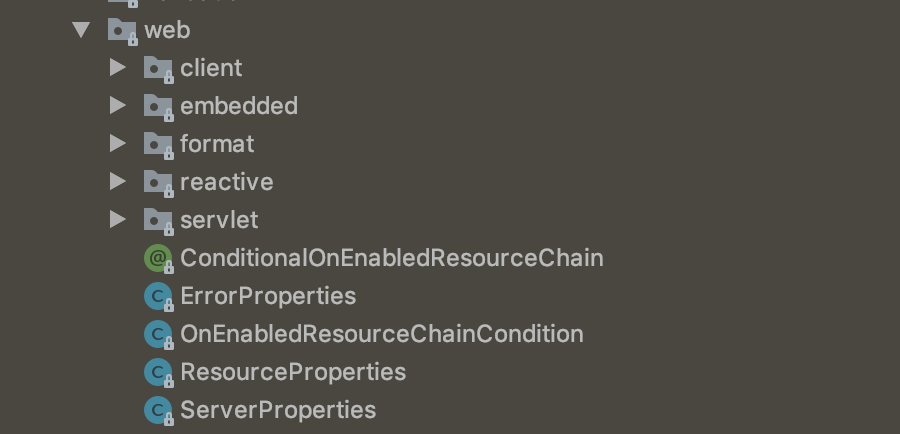SpringBoot--Thymeleaf入门使用
一、概述
今天学习到了SpringBoot中的WEB开发,SpringBoot提供了spring-boot-stater-web为web开发给予支持,它里面内嵌了以下依赖:
<dependencies> <dependency> <groupId>org.springframework.boot</groupId> <artifactId>spring-boot-starter</artifactId> <version>2.1.0.RELEASE</version> <scope>compile</scope> </dependency> <dependency> <groupId>org.springframework.boot</groupId> <artifactId>spring-boot-starter-json</artifactId> <version>2.1.0.RELEASE</version> <scope>compile</scope> </dependency> <dependency> <groupId>org.springframework.boot</groupId> <artifactId>spring-boot-starter-tomcat</artifactId> <version>2.1.0.RELEASE</version> <scope>compile</scope> </dependency> <dependency> <groupId>org.hibernate.validator</groupId> <artifactId>hibernate-validator</artifactId> <version>6.0.13.Final</version> <scope>compile</scope> </dependency> <dependency> <groupId>org.springframework</groupId> <artifactId>spring-web</artifactId> <version>5.1.2.RELEASE</version> <scope>compile</scope> </dependency> <dependency> <groupId>org.springframework</groupId> <artifactId>spring-webmvc</artifactId> <version>5.1.2.RELEASE</version> <scope>compile</scope> </dependency> </dependencies>
主要是Tomcat和Spring MVC的依赖,而web相关的自动配置则在spring-boot-autoconfigure.jar的org.springframework.boot.autoconfigure.web下,如下图所示:

springboot提供的模板引擎有:FreeMarker[fri'mɑːkə(r)]、Groovy['ɡruvi]、Thymeleaf[taɪm'lif]、Velocity[və'lɑsəti]、Mastache['mʌstæʃ],为了准确读出,我加了它们的音标,springboot中推荐使用Thymeleaf作为模板引擎,因为它提供了完美的SpringMVC的支持。关于Thymleaf的语法可以通过官网进行学习https://www.thymeleaf.org/doc/articles/thymeleaf3migration.html
二、通过一个简单的实例举例说明
本例以Thymleaf为模板引擎,从服务端获取数据并展示在页面。
第一步:创建一个Javabean用来在模板页面展示数据person.java
/** * 模板数据 */ public class Person { private String userName; private int age; public Person(String userName, int age) { this.userName = userName; this.age = age; } public String getUserName() { return userName; } public void setUserName(String userName) { this.userName = userName; } public int getAge() { return age; } public void setAge(int age) { this.age = age; } }
第二步:创建Controller
@Controller @SpringBootApplication public class WebdemoApplication { @RequestMapping("/") public String index(Model model) { Person person = new Person("张三", 26); List<Person> people = new ArrayList<>(); Person p1 = new Person("李四", 27); Person p2 = new Person("王五", 27); Person p3 = new Person("赵六", 27); people.add(p1); people.add(p2); people.add(p3); model.addAttribute("singlePerson", person); model.addAttribute("people", people); return "index"; } public static void main(String[] args) { SpringApplication.run(WebdemoApplication.class, args); } }
上面红色加粗部分是将一个用户个一个用户列表设置到model中,传给前页面index.html,所以接下来再创建一个index.html。
第三步:创建页面index.html获取数据
<html xmlns:th="http://www.thymeleaf.org"> <head> <meta content="text/html;charset=UTF-8"> <meta http-equiv="X-UA-Compatible" content="IE=edge"> <meta name="viewport" content="width=device-width,initial-scale=1"> <link th:href="@{bootstrap/css/bootstrap.css}" rel="stylesheet"> <link th:href="@{bootstrap/css/bootstrap-theme.css}" rel="stylesheet"> <link th:href="@{css/demo.css}" rel="stylesheet"> <title>Title</title> </head> <body> <div class="panel panel-primary"> <div class="panel-heading"> <h3 class="panel-title">访问model</h3> </div> <div class="panel-body"> <label>姓名:</label><span th:text="${singlePerson.userName}"/> <label>年龄:</label><span th:text="${singlePerson.age}"/> </div> </div> <div th:if="${not #lists.isEmpty(people)}"> <div class="panel panel-primary"> <div class="panel-heading"> <h3 class="panel-title">访问列表</h3> </div> </div> <div class="panel-body"> <ul class="list-group"> <li class="list-group-item"> <span class="span1">用户名</span> <span class="span1">密码</span> <span class="span3">操作</span> </li> <li class="list-group-item" th:each="person:${people}"> <span class="span2" th:text="${person.userName}"></span> <span class="span2" th:text="${person.age}"></span> <!--<button class="btn" th:onclick="'getName(\''+[[${person.userName}]]+'\');'">获取姓名</button>--> <button class="btn btn-info" th:onclick="getName([[${person.userName}]],[[${person.age}]],this);"> 获取用户信息 </button> </li> </ul> </div> </div> <script th:src="@{jquery-1.8.3.min.js}" type="text/javascript"></script> <script th:src="@{bootstrap/js/bootstrap.js}" type="text/javascript"></script> <script th:inline="javascript"> var single = [[${singlePerson}]]; console.log(single.userName + "--" + single.age); function getName(name, age, obj) { var html = "My name is " + name + " and i am " + age + " years old."; $(obj).parent().append(html); } </script> </body> </html>
创建完之后的目录结构如下:

红色方框中的是web文件的目录,都放在resource目录下了。至此,所有文件创建完成,页面访问效果如下:

这是一个简单的入门例子,主要是熟悉一下Thymeleaf模板的使用,这个例子中用到的主要知识点有以下几个:
1、引入Thymeleaf
- 通过<html xmlns:th="http://www.thymeleaf.org">命名空间,将静态页面转换为动态视图。需要进行动态处理的元素需要使用"th:"作为前缀;
- 通过“@{}”引用web静态资源,如js、css、image等文件;
2、访问model中的数据
- 通过${}访问:如这句<span class="span2" th:text="${person.userName}"></span>,通过“${}” 获取
- 通过[[${}]]访问:如下面这句
<button class="btn btn-info" th:onclick="getName([[${person.userName}]],[[${person.age}]],this);"> 获取用户信息 </button>
这种方式一般用来在javascript中访问model中的数据
3、model中的数据迭代
使用th:each来循环迭代,如
<li class="list-group-item" th:each="person:${people}"> <span class="span2" th:text="${person.userName}"></span> <span class="span2" th:text="${person.age}"></span> <button class="btn btn-info" th:onclick="getName([[${person.userName}]],[[${person.age}]],this);"> 获取用户信息 </button> </li>
person作为迭代元素来使用,这样在下面的元素中就可以通过${person.*}来获取对象的属性了。
4、数据判断
<div th:if="${not #lists.isEmpty(people)}"> .........省略...... </div>
上面代码中,在div内部使用列表数据之前要先判断列表是否为空,就用了${not #list.isEmpty(people)}这样的句式。
Thymeleaf还支持>、<、>=、<=、==、!=等作为条件比较。
以上就是这个入门实例中用到的Thymeleaf中的相关知识,需要注意的是下面这两句:
1、<button class="btn" th:onclick="'getName(\''+[[${person.userName}]]+'\');'">获取姓名</button> 2、<button class="btn btn-info" th:onclick="getName([[${person.userName}]],[[${person.age}]],this);">获取用户信息</button>
这两句都是在HTML中调用js函数时传递model数据的写法,但是第一种会报错!!!
本文来自博客园,作者:bug改了我,转载请注明原文链接:https://www.cnblogs.com/hellowhy/p/10035429.html


